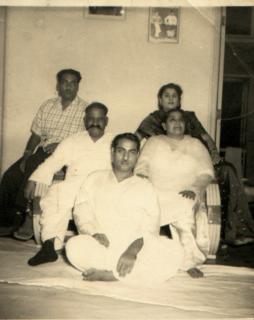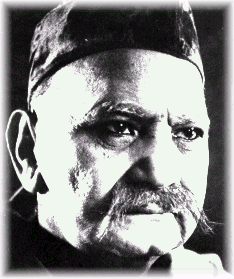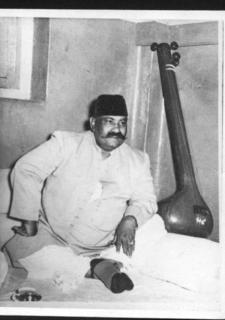Ustad Bade Ghulam Ali Khan, the greatest of them all
Dr. K.Rohiniprasad
 The maestro with his family.
The maestro with his family. Ustad Munawar Ali (front row) provided vocal accompaniment to his father.


The sleeve notes on the long play records of Bade Ghulam Ali Khan (1902-1968) refer to him as the foremost among Hindustani vocalists. He was regarded a phenomenon even by his contemporaries. Born in 1902 in Kasur (West Punjab), Bade Ghulam’s fame as singer was initially limited to areas in and around
The most striking aspect of Ustad Bade Ghulam Ali Khan’s singing is the amazing and effortless phirat of his voice, which ranged through three octaves. He won the appreciation of his illustrious predecessors including Ustad Alladiya Khan, Ustad Faiyaz Khan, Ustad Allauddin Khan (father of Ali Akbar Khan and guru of Pandit Ravi Shankar), Ustad Hafiz Ali Khan (father of the sarod player Amjad Ali Khan). In music festivals Bade Ghulam Ali Khan was invariably the biggest attraction of the evening and no one would dare to perform after his concert. His lilting thumris like Yad piya ki aaye, Kate na birahaki raat, Tirchhi Nazariya ke baan and Prem ke fande me aakar sajani, on records, cut in the forties, are still extremely popular with listeners, not only in India, but all over the world.
The Ustad’s impressive physique and the lofty gait of a monarch were as arresting as the sweet, soul-stirring notes of his music. His friends knew him not only as a versatile singer and an appreciative gourmet and an excellent cook. During his tours of
Bade Ghulam Ali Khan remained a Hindu at heart and his famous compositions like Hari Om Tatsat vouch for this. He was uncomfortable in
The greatest vocalist of the modern era, Bade Ghulam Ali Khan's musical gifts were evident at an incredibly early age. The Ustad could not recall, as an adult, at what age he had begun to master the twelve notes. At the age of three or four, even as he started talking, he learnt sargams as a child learns his mother tongue. Recognising the musical prodigy in him, his father Ali Bux put him, at the age of seven, under the tutelage of Ustad Kale Khan of
After Kale Khan’s death, Ghulam Ali continued his training under his father. For the youngster, music became the sole passion and he practised day and night. His joys and sorrows were centred on music. Gifted with a great musical lineage, intelligence, sound training and high artistic sensibility, the purity of the note for him became the supreme thing, Other musicians including Ashiq Ali (of Tanras Khan gharana) and Baba Sindhi Khan groomed him later and some critics detect the influence of Ustad Wahid Khan his khayal alap. Bade Ghulam Ali Khan’s genius added rare polish and glow to the style of
Bade Ghulam Ali Khan has influenced hundreds of singers trying to emulate him and thousands of music lovers who cherish his music. No other North Indian vocalist ever attracted such large audiences in the South as did Bade Ghulam Ali Khan. Whether it was a sedate khayal, a romantic thumri or a devotional bhajan, the Ustad would put his heart and soul into the song. This made contemporary musicians and music lovers realise not only the importance of voice culture and modulation, but also the value of emotion in music. While many musicians sing perfectly and correctly, impressing the listener's intellect, very few of them can touch the heart as Bade Ghulam Ali Khan could. The remarkable pliability of his voice, the amazing swara combinations, the incredible speed of his taans and the ease with which he could sway his audiences by his emotional renderings that brought every rasa to life, were the envy of contemporary musicians. His varied and richly expressive style, the rare perfection of rendering the composition resulted in great popularity for the
Ustad Bade Ghulam Ali Khan belonged to the era during which film music became a powerful attraction to the general public. In spite of its great commercial value, the appeal of film music is short-lived. As other films come along the old film and its songs are gradually forgotten. Classical music has a lasting hold on the interest of listeners in spite of the fact that recordings of classical music do not sell as fast as film music. Nor does its value to music lovers decline. Here we should ignore the present fancy that focusses more on the appearance and the hype that surrounds classical musicians rather than their music. In this context, the contribution of Bade Ghulam Ali Khan assumes special significance. The larger-than-life image of this legendary musician made his fans and other musicians hold him in deep awe.
Hailing from
On behalf of HMV, G.N.Joshi had to use a lot of tact and guile to get the reluctant Ustad to record his music in the forties and these 78RPM discs remain unique to this day. In the early sixties, as long playing records became popular, initial efforts to persuade the Ustad to cut discs did not fructify. In 1963 when his health started deteriorating, he set aside his initial demand for a hefty remuneration and recorded two LPs. This was followed by other recordings. Today, apart from many private collections, more of his recordings are available from the archives of the All India Radio.
Musicians like Pandit Jagannathbua Purohit, Professor B. R. Deodhar and others had close personal interaction with the Ustad during his stay in


1 Comments:
Great Historical Post About a Great Maestro of Patiala Gharana.... Undoubtedly he is the greatest of All till now ever recorded for Patiala Gharana. Unparallel !!!
After Legendary ustad Faiyaz Khan (agra Gharana) he was really great.
Post a Comment
<< Home